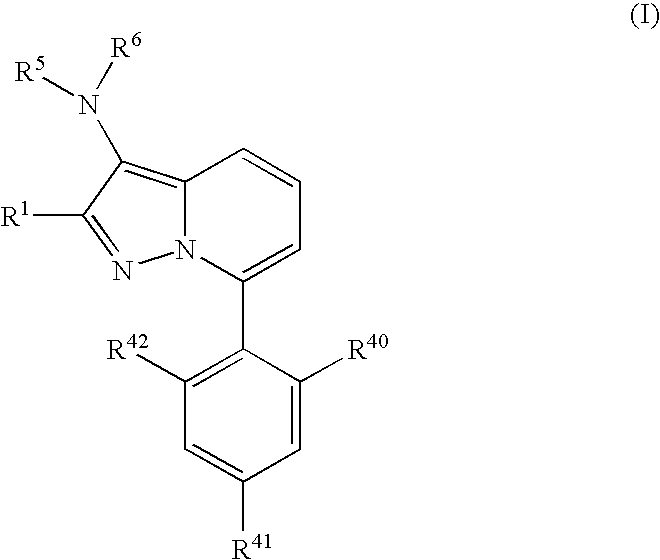7-Phenyl pyrazolopyridine compounds
a pyrazolopyridine and compound technology, applied in the field of compound with antagonistic activity of the corticotropinreleasing factor receptor, can solve the problems of low utility value of peptide derivatives as drugs, and achieve excellent anti-crf receptor activity
- Summary
- Abstract
- Description
- Claims
- Application Information
AI Technical Summary
Benefits of technology
Problems solved by technology
Method used
Image
Examples
production example 1
2-(1-Butynyl)pyridine
[0164]
[0165] To a solution of 2-bromopyridine (50 g) dissolved in diethylamine (500 mL) was added dichlorobis(triphenylphosphine)palladium(II) (2.2 g) and copper iodide (0.3 g), and the reaction mixture was stirred for 4 hours at room temperature while introducing 1-butyne (100 g) as a gas. The resulting reaction mixture was bubbled with nitrogen, and then ethyl acetate was added. After the reaction mixture was filtered through celite to remove insoluble residue, the filtrate was washed with water and brine. The obtained organic extract was dried over anhydrous magnesium sulfate and filtered, the solvent was evaporated under reduced pressure, the residue was purified by silica gel column chromatography and the title compound (35 g) was obtained as a brown oil from the n-hexane:ethyl acetate (5:1) fraction.
[0166]1H NMR (400 MHz, CDCl3) δ 1.26 (t, J=7.6 Hz, 3H), 2.45 (q, J=7.6 Hz, 2H), 7.16-7.20 (m, 1H), 7.35-7.38 (m, 1H), 7.59-7.63 (m, 1H), 8.53-8.54 (m, 1H).
production example 2
2-Ethylpyrazolo[1,5-a]pyridine
[0167]
[0168] To a solution of 2-(1-butynyl)pyridine (12.8 g) dissolved in dichloromethane (60 mL) was added a solution of O-mesitylenesulfonylhydroxylamine (Reference; Synthesis, 1997, 1) (20 g) in dichloromethane (132 mL) while cooling with ice, and the reaction mixture was stirred for 30 minutes. Diethyl ether (2 L) was added to the reaction mixture to precipitate crystals, which were filtered off and then dried under reduced pressure to afford a crude product of N-amino-2-(1-butynyl)pyridinium mesitylenesulfonate (12.6 g) as colorless crystals.
[0169] A portion (6.1 g) of the obtained crude product of N-amino-2-(1-butynyl)pyridinium mesitylenesulfonate was dissolved in tetrahydrofuran (600 mL), and then potassium tert-butoxide (3.55 g) was added thereto at room temperature and the reaction mixture was vigorously stirred for 30 minutes. After adding ice water to the obtained reaction mixture, extraction was performed with ethyl acetate. After re-extr...
production example 3
7-Bromo-2-ethylpyrazolo[1,5-a]pyridine
[0171]
[0172] To a solution of 2-ethylpyrazolo[1,5-a]pyridine (80 mg) dissolved in tetrahydrofuran (1 mL) was added n-butyllithium (1.6M hexane solution: 0.58 mL) dropwise at −78° C. under a nitrogen stream, and the reaction mixture was further stirred for 30 minutes at the same temperature. A solution of 1,2-dibromo-1,1,2,2-tetrachloroethane (196 mg) in tetrahydrofuran (0.5 mL) was added dropwise to the reaction mixture, and stirring was continued for 30 minutes. After raising the temperature to room temperature and adding water to the reaction mixture, extraction was performed with ethyl acetate and the organic extract was washed with water and brine. The obtained organic extract was dried over anhydrous magnesium sulfate and filtered, the solvent was evaporated under reduced pressure, the residue was purified by silica gel column chromatography and the title compound (90 mg) was obtained as a light brown oil from the n-hexane:ethyl acetate (2...
PUM
| Property | Measurement | Unit |
|---|---|---|
| Molar density | aaaaa | aaaaa |
| Molar density | aaaaa | aaaaa |
| Molar density | aaaaa | aaaaa |
Abstract
Description
Claims
Application Information
 Login to View More
Login to View More - R&D
- Intellectual Property
- Life Sciences
- Materials
- Tech Scout
- Unparalleled Data Quality
- Higher Quality Content
- 60% Fewer Hallucinations
Browse by: Latest US Patents, China's latest patents, Technical Efficacy Thesaurus, Application Domain, Technology Topic, Popular Technical Reports.
© 2025 PatSnap. All rights reserved.Legal|Privacy policy|Modern Slavery Act Transparency Statement|Sitemap|About US| Contact US: help@patsnap.com



